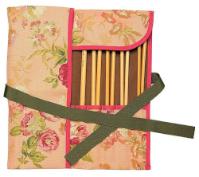When deciding on what needles to invest in, you’ll want to consider what type of knitter you are and what type of projects you’re interested in. A fair amount of patterns, from sweaters to scarves, call for U.S. size 8/5 mm or 10/6 mm needles. So you’ll probably want to own these sizes. If you find yourself enamored by sock making you’ll want to stock up on U.S. size 0/2mm and 1/2.25mm. So how do you go about acquiring these needles in an eco-conscious manner? Choose Bamboo – Bamboo is a fast growing natural material that is used in a wide range of sustainable products. Over at Core77, you can read the pros and cons of bamboo as a “green” material. Needles made from bamboo are widely available at any craft store and are lightweight, virtually noiseless and easy on the hands. They are just the right texture to have ease of movement and are able to hold your stitches without fear of them falling off of your needle. Takumi is a brand of knitting needles that are made from bamboo and are pretty common here in the States. Takumi also has a new version of their bamboo needles called Velvet. These bamboo needles claim eco-friendliness since no petro-chemicals are used in their finishing. Choose knitting needles made from bamboo when you want to own common size needles for your everyday projects. Beg, Borrow and Deal – If you want to start a project that calls for a needle size that you don’t have, ask around. Inquire at your local Stitch ‘n’ Bitch group as someone there is sure to have the size you need and might be willing to lend you the requested pair for the duration of your project. I’ve also heard of some Stitch ‘n’ Bitch groups pooling their needles to form a sort of knitting needle library where you can “check out” the size you need. Another great source for needles is the thrift store and rummage sales. I’ve personally had great luck in finding used needles at garage sales for pennies. Try to borrow needles first, then try to find used needles before buying new. Create your own – Last but not least, you can make your own knitting needles from wooden dowels, chopsticks and skewers. Use the techniques found here, here and here when you have leftover supplies from other projects. You can then personalize your needles with paint and create end stoppers made from buttons, fimo or even small rocks. Image from Patternworks.
